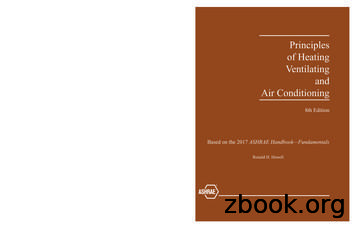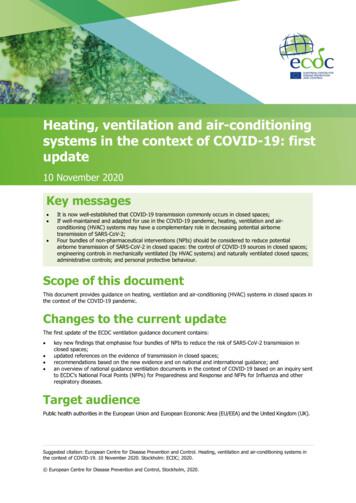Heating, Ventilation, And Air Conditioning (hvac) - Mid-State Technical .
2019/2020heating, ventilation, and airconditioning (hvac)Technical DiplomaProgram Code: 30-401-4Total Credits: 25CHECKLIST:This section will be completed whenmeeting with your academic advisor. FAFSA (www.fafsa.gov)Mid-State’s Heating, Ventilation, and Air Conditioning programprovides the hands-on foundation needed for an entry-level positionin the heating, ventilation, air conditioning (HVAC) fields. Graduateswill understand the various components of heating, ventilation,air-conditioning, and refrigeration systems, including furnaces,ductwork, boilers, hydronic piping, HRVs (heat recovery ventilators),evaporators, condensers, circuits, and controls. Students will alsoexplore geothermal, biomass, and solar heating systems. Throughhands-on classroom lab activities, students will join various pipingtypes, design and construct ductwork, and install a completeresidential HVAC system. They will also learn the electrical skillsnecessary to read wiring diagrams and troubleshoot mechanicalcontrol systems. Graduates are prepared to take the EPA 608Technician Certification exam for refrigerants. Financial Aid Form(s)Form(s): Follow-Up Appointment:Where:When:With: Official TranscriptsMid-State Technical CollegeAttention CPL Coordinator500 32nd Street NorthWisconsin Rapids, WI 54494 Other:Estimated tuition and fees: mstc.edu/programcostsACADEMIC ADVISORTo schedule an appointment with an academic advisor, call715.422.5300. Academic advisors will travel to other campuses asnecessary to accommodate student needs. For more informationabout advising, visit mstc.edu/advising.mstc.edu888.575.6782ADAMS CAMPUS401 North MainAdams, WI 53910MARSHFIELD CAMPUS2600 West 5th StreetMarshfield, WI 54449STEVENS POINT CAMPUS1001 Centerpoint DriveStevens Point, WI 54481WISCONSIN RAPIDS CAMPUS500 32nd Street NorthWisconsin Rapids, WI 54494Mid-State does not discriminate on the basis of race, color, national origin, sex, disability, or age in its program, activity, or employment. The following person has been designatedto handle inquiries regarding the nondiscrimination policies: Vice President – Human Resources; 500 32nd Street North, Wisconsin Rapids, WI 54494; 715.422.5325. 3/2019
career pathwayBACHELOR'S DEGREEOPTIONSSTARTYOURCAREEREARN ABACHELOR’SDEGREEUW-River FallsBS Sustainable ManagementRENEWABLEENERGYTECHNICIANUW-StoutBS Sustainable ManagementCAREEROPTIONSEnergy Load EstimatorRenewable Energy TechnicalSales RepresentativeSolar InstallerASSOCIATE INAPPLIED SCIENCEFor more information andadditional opportunities,visit mstc.edu/transfer.ONLY 35MORE CREDITSSTARTYOURCAREERHEATING,VENTILATION, ANDAIR CONDITIONINGCAREEROPTIONSBuilding Controls TechnicianHVAC InstallerHVAC TechnicianTECHNICALDIPLOMAONLY 13MORE CREDITSSTARTYOURCAREEROTHER OPTIONSAPPRENTICESHIPOPPORTUNITIES CONSTRUCTIONTRADESCarpenter ApprenticeshipElectrician ApprenticeshipPlumber ApprenticeshipSteamfitter ApprenticeshipSteamfitter ServiceApprenticeshipCAREEROPTIONSElectrical Contracting LaborerCarpentry Contracting LaborerPlumbing Contracting LaborerTECHNICALDIPLOMA12 ULTCollege Credit Dual Credit Military Experience Work ExperienceLearn about Credit for Prior Learning at mstc.edu/cpl.BEGIN AT ANY POINTIN THE PATHWAYPage 2888.575.6782 Get the latest updates online at mstc.edu
PROGRAM OUTCOMESGRADUATION REQUIREMENTEmployers will expect you, as a Heating, Ventilation, and AirConditioning (HVAC) graduate, to be able to:The GPS for Student Success course is required for allMid-State students and must be completed prior toobtaining 12 credits. (Not counted in the total credit valuefor this program.) Join pipes or tubing to equipment and to fuel, water, orrefrigerant source to form complete circuit. Test pipe or tubing joints or connections for leaks, usingpressure gauge or soap-and-water solution. Lay out and connect electrical wiring between controlsand equipment, according to wiring diagrams, usingelectrician’s hand tools. Install, connect, and adjust thermostats, humidistats, andtimers using hand tools. Test electrical circuits or components for continuity usingelectrical test equipment. Repair or replace defective equipment, components,or wiring. Obtain and maintain required certifications. Install ductwork and test for leaks. Size and lay out ductwork. Comply with all applicable standards, policies, andprocedures, including safety procedures and themaintenance of a clean work area. Inspect and test systems to verify systemcompliance with plans and specifications or todetect and locate malfunctions.TECHNICAL SKILLS ATTAINMENTGPS for Student Success10890102 . 1 creditIntegrate necessary skills for student success by developingan academic plan, identifying interpersonal attributes forsuccess, adopting efficient and effective learning strategies,and utilizing Mid-State resources, policies, and processes.This course must be completed prior to obtaining 12 creditsand as a graduation requirement.ADDITIONAL COURSES AS NEEDEDThe following courses may be recommended or required ifthe student does not achieve minimum Accuplacer scores.Intro to College Reading10838104 .2 creditsProvides learners with the opportunities to developand expand reading skills, including comprehensionand vocabulary skills. Learners apply reading skills toacademic tasks and read to acquire information from avariety of sources.Intro to College Writing10831103 .3 creditsThe Wisconsin Technical College System (WTCS) hasimplemented a requirement that all technical collegesmeasure program outcomes attained by students. Thisrequirement is called Technical Skills Attainment (TSA).The main objective of TSA is to ensure graduates have thetechnical skills needed by employers. Students are notifiedof TSA reporting in their final few courses of the program.Introduces basic principles of composition, includingorganization, development, unity, and coherence inparagraphs and multi-paragraph documents. The purpose ofthis course is to prepare students for successful entry intorequired program courses. This course is tuition bearing andunder certain circumstances may qualify for financial aid.This course cannot be used to satisfy program completionrequirements at Mid-State.STUDENT HANDBOOKPrerequisite: Accuplacer Sentence Skills score of 60 or equivalent.Proficiency in word processing skills recommended.Visit mstc.edu/studenthandbook to view Mid-State’sstudent handbook, which contains information aboutadmissions, enrollment, appeals processes, services forpeople with disabilities, financial aid, graduation, privacy,Mid-State’s Student Code of Conduct, and technology.Pre-Algebra10834109 .3 creditsProvides an introduction to algebra. Includes operationson real numbers, solving linear equations, percent andproportion, and an introduction to polynomials andstatistics. Prepares students for elementary algebra andsubsequent algebra-related courses.Prerequisite: Accuplacer Math score of 65, Accuplacer Algebra scoreof 30, ABE Math Prep V 76854785 and ABE Math Prep VI 76854786with a grade of “S.” (Note: ABE Math Prep V and VI courses cannotbe used to satisfy program completion requirements at Mid-State.)888.575.6782 Get the latest updates online at mstc.eduPage 3
SAMPLE FULL-TIME CURRICULUM 10601140TermSAMPLE PART-TIME CURRICULUM OPTION12 creditsIntro to WeldingConstruction FundamentalsPiping ApplicationsHVAC Heating FundamentalsBlueprint Reading for Construction TradesElectricity for the Construction Trades12322213 creditsSustainable Heating SystemDesign & Installation10483115 Energy Load Estimation and Modeling10483130 Electrical Controls & Systems for Buildings10601120 HVAC Air Conditioning Fundamentals10601121Intro to HVAC InstallationTerm8 credits10442100104831211060111010601140TermTotal credits 25Please Note: This curriculum sequence is only for student planning. Actualstudent schedules will vary depending on course availability. Program completion time may vary based on student schedulingand course availability. For details, go to mstc.edu/classfinder.10601120TermConstruction FundamentalsSustainable Heating SystemDesign & InstallationHVAC Air Conditioning Fundamentals2325 credits1048311510601130Term13227 credits10482107104831101048311033322Intro to WeldingPiping ApplicationsHVAC Heating FundamentalsElectricity for the Construction TradesEnergy Load Estimation and ModelingBlueprint Reading for Construction Trades325 credits10483130 Electrical Controls & Systems for Buildings10601121Intro to HVAC Installation32Total credits 25NOTES:Page 4888.575.6782 Get the latest updates online at mstc.edu
course descriptionsBlueprint Reading for Construction Trades10601130 .2 creditsHVAC Air Conditioning Fundamentals10601120 .2 creditsDevelops the ability to read blueprints for commercial andnon-commercial structures. Emphasizes blueprints drawnby licensed architects, covering plumbing, electrical wiring,structural framing, millwork, interior and exterior details, andbasic information.Topics include air conditioning principles and terms, physicalprinciples of air movement, air filtering and humidity,and methods of conditioning air for comfort and health.Also covers the proper use of psychrometers, dry bulbthermometers, hygrometers, and reading and interpretationof psychrometric charts and scales as well as ASHRAE andBPI ventilation standards for residential units. (HVAC is acommon industry reference to heating, ventilation, and airconditioning.)Construction Fundamentals10482107.2 creditsStudies the concepts associated with the theory, materials,and methods used in construction, including footings andfoundations, walls, floors, roofs and roof materials, exteriorfinishes, interior walls, ceiling and floor finishes, insulationtypes, vapor and air infiltration, and sound protection.Students also become familiar with blueprint reading andexamine all trades associated with construction, including,electrical, HVAC, and plumbing. Safe use of the appropriatetools for each trade is covered.Electrical Controls & Systems for Buildings10483130.3 creditsTopics include an introduction to AC/DC electricity andthe physical laws that apply to electronic circuits. Directcurrent (DC) covers basic definitions of voltage, current, andresistance and analysis of series and parallel resistive circuits.Alternating current (AC) includes an introduction to ACgeneration, capacitors, inductors, and transformers and theirapplications in electronic circuits. Additional topics includecontrol circuits, symbols, diagrams, protection devices, relays,thermostats, single-phase motors, control components, andtroubleshooting ACR system wiring diagrams.Corequisite: Electrical Circuits I 10605105 or Intro to Electronics10605108 or Electricity for the Construction Trades 10601140Electricity for the Construction Trades10601140 .2 creditsThis course is an introduction to electrical theory andapplication for those in the construction and building trades.Content includes AC and DC circuits, schematics, Ohms law,multimeter use and circuit troubleshooting. This course willalso provide an introduction to the contents of the NationalElectric Code (NEC).Energy Load Estimation and Modeling10483115.3 creditsIn this course students will develop the skills to doresidential and light commercial energy load estimations.Students will calculate heating and cooling building loadsand estimate energy consumption rates and quantities.The student will also estimate energy upgrades such asinsulation, window improvements, etc. and calculatingpayback and fuel savings. The course covers a variety ofcomputer programs available for analyzing buildings.888.575.6782 Get the latest updates online at mstc.eduHVAC Heating Fundamentals10601110 .2 creditsProvides an introduction to how homes and buildings areheated. Topics include introduction to heat principles,temperature measurement, fuels and other sources of heat,combustion, basic heating systems, basic furnace design,boiler design and operation, venting of furnaces, chimneyor exhaust gases, and system controls. (HVAC is a commonindustry reference to heating, ventilation, and air conditioning.)Intro to HVAC Installation10601121 .2 creditsAddresses residential and light commercial heating andcooling systems. Emphasizes the diversity of heating andcooling systems and how they operate. Students participate inthe installation of a variety of HVAC systems and troubleshootand service systems. (HVAC is a common industry reference toheating, ventilation, and air conditioning.)Intro to Welding10442100 . 1 creditBuilds knowledge of general welding shop procedures andsafety, arc welding principles and equipment setup, andmetal fabrication equipment use. Students work with a labinstructor to begin developing skills with the gas metal arcwelding (GMAW) and gas tungsten arc welding (GTAW)welding processes by completing simple welding andfabricating tasks in preparation for further exploration inwelding and fabricating.Piping Applications10483121.3 creditsPresents the fundamentals of plumbing and pipinginstallation practices. Laboratory activities provide studentswith basic pipe joining processes associated with theplumbing and HVAC industries.Sustainable Heating System Design & Installation10483110 .3 creditsAddresses solar thermal, geothermal, and biomass heatingsystems. Students participate in the installation anddesign of a solar hot water system. Topics include safety;system design and layout; component selection; mountingcollectors; installing and insulating copper tubing; andinstalling a storage tank, heat exchanger, circulation pump,and other system components.Page 5
combustion, basic heating systems, basic furnace design, boiler design and operation, venting of furnaces, chimney or exhaust gases, and system controls. (HVAC is a common industry reference to heating, ventilation, and air conditioning.) Intro to HVAC Installation 10601121 .2 credits Addresses residential and light commercial heating and .
Technical Diploma Program Code: 31-401-3 Total Credits: 27 Mid-State’s Heating, Ventilation, and Air Conditioning (HVAC) Installer program provides the hands-on foundation needed for an entry-level position in the heating, ventilation, air conditioning (HVAC) fields. Graduates will understand the various components
design an air conditioning system for a shopping mall with proper distribution of air and also separate energy consumption system for different vendors. Keywords:HVAC, Air-Conditioning,Refrigeration, HACR. I. INTRODUCTION HVAC (heating, ventilating, and air conditioning; also heating, ventilation, and air conditioning) is the technology
District heating often involves a heating substation installed in the basement of a building. It receives the heating carrier from a heat generating station and via a heat exchanger makes it available for the building heating system. An individual heating system in many cases consists of a boiler heating water up to required temperature for
His industrial and consulting engineering experience ranges from ventilation and condensation problems to the development and implementation of a complete air curtain test program. The following authors contributed significantly to the textbook Principles of Heating, Ventilation, and Air Conditioning.
facilities management 2020- design & construction edition: march 23. 4202 e. fowler avenue, opm 100 tampa, florida 33620-7550 phone: (813) 974-2845 website: usf.edu/fm-dc division 23 heating, ventilating & air conditioning page 1 of 43 design & construction guidelines division 23 heating, ventilating & air conditioning (hvac) division 23 heating, ventilating & air condiitoning (hvac)
Evacuate and Charge the Air Conditioning System (A7-E-4) 30 Chapter 15 - A/C System Diagnosis and Service Air Conditioning System Performance Test (A7-A-1, A7-A-3) 31 Air Conditioning Noise Diagnosis (A7-A-4) 32 Refrigerant Identification/Read Pressures (A7-A-5) 33 Leak Test the Air Conditioning System (A7-A-6) 34
Ventilation systems provide clean air by exchanging indoor and outdoor air and filtering. Air-conditioning systems can be part of integrated HVAC systems or stand-alone, providing air filtering and/or cooling/warming and dehumidification . Stand-alone systems usually recirculate the air with out mixing it with outdoor air .
Thermal and System Management Approach for Exhaust Systems Amit Deshpande, Frank Popielas, Chris Prior, Rohit Ramkumar, Kevin Shaver Sealing Products Group, Dana Holding Corporation Abstract: The automotive and heavy-duty industry (off- and on-highway) requirements for emission, noise and fuel reduction and control have become more stringent. Based on the complexity of the system with its .






















